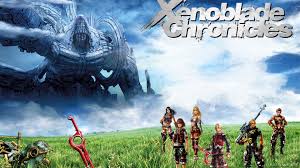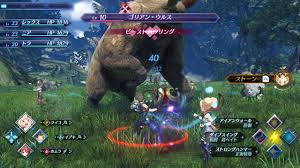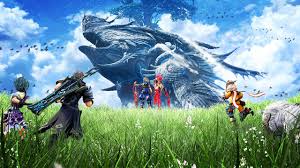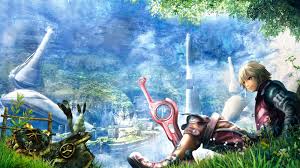Xenoblade Chronicles
I'm wishing everyone and every living creature around the world a very good morning... I'm back with today's game review and i hope you like it!
.jpg)
Source
Xenoblade Chronicles is an action role-playing game developed by Monolith Soft and published by Nintendo for the Wii. Initially released in Japan in 2010, it was later released in Europe in 2011 and in North America in 2012. A port for the New Nintendo 3DS was released worldwide in 2015. Xenoblade Chronicles forms part of the Xeno metaseries, although no direct narrative connections exist to previous Xeno games, and incorporates aesthetic and narrative elements from both fantasy and science fiction. The game features navigation through an open world split into zones, side-quests tied to party members' affinity, and a real-time action-based battle system which incorporates the main character's ability to see glimpses of the future.
.jpg)
Source
Xenoblade Chronicles takes place on the frozen bodies of two warring titans, the Bionis and the Mechonis. The people of Bionis, including the human-like Homs, are in a perpetual war with the Mechon machine race of Mechonis. Key to the Homs' efforts in fighting the Mechon army is the Monado, a sword said to have been wielded by the Bionis. During an attack on his colony, the main protagonist Shulk discovers his ability to wield the Monado, and he sets out on a quest for revenge with his best friend, Reyn, with others joining in as the game progresses.
.jpg)
Source
The concept for Xenoblade Chronicles originated in June 2006 when the game's executive director and lead writer, Tetsuya Takahashi, visualized and then constructed a model of two giant gods frozen in place with people living on their bodies. Development began in 2007 under the title Monado: The Beginning of the World, though it was eventually rebranded with its current title in honor of Takahashi's previous work. The script was worked on by Takahashi, anime writer Yuichiro Takeda, and in-house Nintendo writer Yurie Hattori. The music was handled by six different composers, including first-timer and lead composer Manami Kiyota and industry veterans Yoko Shimomura and Yasunori Mitsuda, with the latter writing the ending theme.
.jpg)
Source
The game was announced in 2009 under its original title, and released in Japan the following year. Despite releasing in Europe, its North American release remained unconfirmed until December 2011, during which time a fan campaign called Operation Rainfall had drawn considerable attention to the game. Upon release, the game received critical acclaim as one of the best recent role-playing games, while its port was praised for successfully re-creating the game in portable form. It also met with commercial success in both Japan and the West. A spiritual successor by the same development team for the Wii U, Xenoblade Chronicles X, was released in 2015. A sequel for the Nintendo Switch, Xenoblade Chronicles 2, was released in 2017.
.jpg)
Source
Xenoblade Chronicles plays as a role-playing video game (RPG), where the player controls one character out of a party of three using the Wii Remote and Nunchuk or the Classic Controller. The game employs an open world design, with players able to freely navigate seamlessly interconnected environments. A day-and-night time cycle exists in the game, with the time of day often affecting in-game events, quests, enemy strengths, and item availability: for instance, stronger enemy types appear at night. While time flows automatically and a day cycle repeats about every ten minutes in real time, players can adjust the in-game clock to the desired time at any point. Additionally, while the game is about exploration, many areas, called "Landmarks" aid in traversing the land by serving as warp points, allowing the player to instantly return to that point at any time. The game also supports a "save anywhere" feature, where players can save at any point outside battle. The game also contains a New Game+ mode, which pulls over much of the player's progress from their first playthrough into future play throughs.
.jpg)
Source
Exploration, quest completion, and item collection are large parts of the gameplay. The player is encouraged to explore the large environments, which generally allow the player to visit whatever can be seen in the horizon. While exploring, the player may choose to take on side quests from various non-player characters that inhabit the game's world, as they commonly involve locating certain items or killing a certain number of enemy characters. When the necessary requirements are fulfilled, some of the quests are completed automatically without the player needing to manually notify in-game characters of its completion. Item collection plays a role in the game in the form of the game's "Collectopaedia". Scattered across all major regions of the game are glowing blue orbs, and upon coming into contact with the orb, the player is awarded an item at random, which is added to the player's inventory. From there, the player may add the item to the Collectopaedia, and when a certain number are collected during exploration, the player is rewarded with new items. Aside from the Collectopaedia, there are also ether crystals to be found from fallen enemies or ether crystal deposits, which give the player access to a multifaceted "Gem Crafting" mini-game, allowing for the creation of gems that may increase battle stats when equipped.
.jpg)
Source
Many in-game systems affect the general flow of gameplay. The "Affinity" system tracks the relationships between characters and locations in the game. "Location Affinity" tracks the interpersonal relationships between all of the game's named characters, depicting to which degree they get along with one another, and a town's general perception of the player's controllable party. Completing quests can alter perception of the characters, and open up additional story sequences. There is also "Party Affinity", which is strictly the level of affection between each party member, ranging from indifference to love. These affinities can be raised by having characters participate in battle together, giving gifts, or using the "Heart-to-Heart" system. These "Heart-to-Hearts" are intimate moments between two characters that can show more of a character's personality, history, or thoughts, and can be initiated by having a certain level of Affinity between them. The Affinity system ties into how efficient characters work together in battle and gem crafting. The game also has an extensive customization system, which includes changing the characters' outfits and weapons. These changes are directly reflected in the game, appearing in the field and even during scripted cut scenes.
.jpg)
Source
Thanks for coming this far and i hope you like the game... I'll see you tomorrow..... Peace